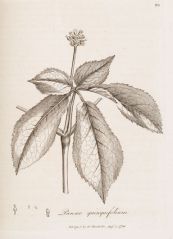Gilded Ginseng
By Audrey Stallsmith

It fills the heart with hilarity while its occasional use will, it is said, add a decade of years to the ordinary human life. Can all these millions of Orientals, all those many generations of men, who have boiled Ginseng in silver kettles and have praised heaven for its many benefits, have been totally deceived?
Sir Edwin Arnold, 1832-1904
Asians originally revered ginseng for much the same reason Europeans venerated mandrake. The roots of both plants can appear man-shaped. The word "ginseng", in fact, derives from the Chinese jen shen ("like a man"). It official name panax comes from the Greek panakes ("panacea"), meaning a remedy for all ills.
There are three varieties of the plant popular today: the Asian Panax ginseng, the American Panax quinquefolius ("five-leafed"), and the Russian Eleutherococcus senticosus. Although Russian ginseng is not a panax, it also belongs to the aralia (ivy) family and its effects are similar. It must be a spinier plant, though, since senticosus means "thorny". Eleutherococcus might be loosely interpreted as "Mongolian seed". Nicknames for ginseng include manroot, life root, ninsin, garantoquen (the Native American name), 'sang, 'seng, and red berry.
It was so popular in Asia that the supply eventually ran low there. A Jesuit priest stationed in Manchuria, Father Jartoux, described ginseng and its value in his writings. A Canadian Jesuit, Father Lafitau, concluded that his climate resembled Manchuria. So he set out to see if he could locate a similar plant. When he succeeded, the Jesuits made a tidy profit exporting American ginseng to the Chinese.
By 1748, shipping agents were paying $1 per pound for ginseng and selling it for $5 per pound in Asia. In those days, that made the herb the colonies' most valuable export. (A recent article I read puts the current price at about $350 per pound for wild ginseng, only about a tenth that for the domesticated variety.)
It's no wonder that everybody began to keep an eye out for the herb with its distinctive cluster of red berries. One story has Daniel Boone losing 12 tons of ginseng roots when his boat upset in the Ohio River. (Talk about a sinking feeling!) That may simply be a legend, since 12 tons is a heap o' sang! It generally takes at least three pounds of fresh root to make one pound dried.
Native Americans had a habit of bending down the fruited stems, to assist in propagation of new plants, before digging the roots. But the colonists were not so foresighted, and the American woods were virtually stripped of the plant. Although a number of hillbilly superstitions grew up around 'sanging--such as that one should skip the first three plants discovered---ginseng never became as popular here as in Asia. Perhaps people have always been too busy shipping it out to try it!
It has long had a reputation in China and Russia as a tonic for the aged, a stimulant for athletes, and a heal-all for virtually every ailment under the sun. Ginseng is said to fight viruses, boost immunity, reduce cholesterol and blood sugar, thin the blood, protect the liver, treat colds and other respiratory problems, ease depression and menstrual difficulties, and shrink tumors--not to mention increasing fertility and desire. In the 1600's a William Byrd of Virginia wrote that ginseng "frisks the spirits!"
Many American scientists still disdain the plant, and consider its benefits largely all in the mind. They also point out that there can be side effects such as insomnia, diarrhea, high blood pressure, allergy attacks, and hormonal disturbances. Their frequent failure to achieve good results may, however, be blamed on the steep price of the herb.
Because ginseng is so expensive, most products bearing its name are diluted, adulterated with other plants, or made with immature roots. Some of those side effects might actually be attributable to the adulterants rather than to ginseng itself. In fact, what was once advertised as "wild red" or "desert" ginseng was found to be nothing more than red dock--a known laxative! Also ginseng often requires a month or so of steady use before any changes are noted.
To afford ginseng, you almost have to grow it yourself. And that is much easier said than done! The plant is quite susceptible to fungus, and the seeds often don't sprout until the second spring after they are planted. Ginseng also requires rich but light soil, about 80% shade, and 6 years to reach full maturity. (You can tell a root's age by counting "scars" from previous leafstalks.)
Ginseng grows best in raised beds of sandy loam or clay soil lightened with humus, in high shade, and heavily mulched with dead leaves. Most problems arise from too much sun, over-crowding of plants, or poor drainage.
Today most of the ginseng exported from the U. S. is cultivated in Marathon County, Wisconsin. Growers once used wooden lath or fast-growing vines like wild cucumber to shade their beds, but nylon mesh is more popular today. Domesticated plants and roots are larger and grow faster. "Farmed" plants can reach two feet in height, the wild ones seldom more than 15 inches. But wild roots are still considered to have better quality and stronger flavor. So a few fur buyers still purchase ginseng too, as in days of yore.
Because wild ginseng is endangered, please plant the berries from any patch you dig. If the ginseng you find isn't producing berries yet, it definitely isn't mature enough to be harvested.
In China, the poor use Codonopsis tangshen as a substitute for ginseng. The more impatient and underpriveleged of us might want to do the same.
In the meantime, ginseng can remind us that coddled people like coddled plants may appear more prosperous, but are often as bland as over-fertilized herbs. It is those who have had to struggle for survival who take on the real flavor
Panax quinquevolium image is from Medicinal Botany by William Woodville, courtesy of the Missouri Botanical Garden.








